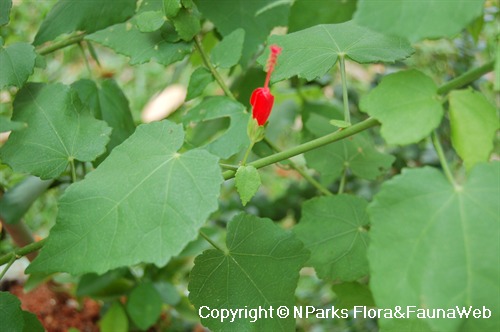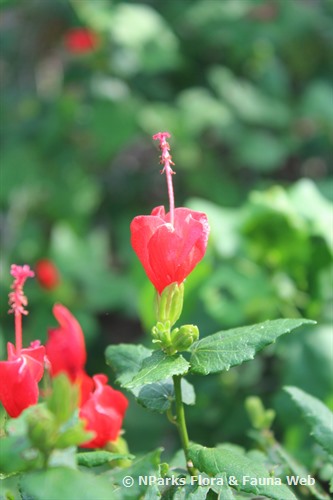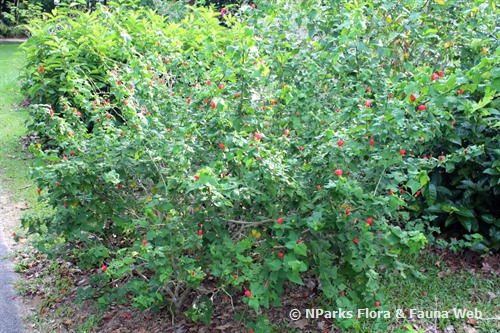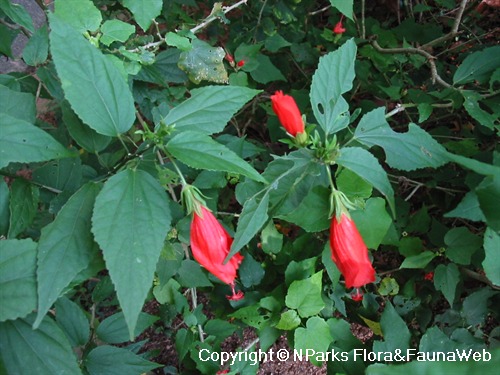
Back
Malvaviscus arboreus Cav.
| Family Name: | Malvaceae |
| Common Name: | Sleepy Mallow, Wax Mallow, Mexican Turk's Cap, Turk's Turban, 小悬铃花 |
The Sleepy Mallow is part of the Hibiscus family and originates from Central and North America. It is loved for its bright red flowers; when fully opened, the flower petals are wrapped around its stamen, looking like an unopened hibiscus flower. It blooms all year, grows well in Singapore's tropical climate and is easily propagated via seed or stem cutting. This evergreen plant attracts sunbirds which enjoy the sweet nectar and serves as a beautiful addition to attract wildlife to gardens!
Name
Classifications and Characteristics
| Plant Division | Angiosperms (Flowering Seed Plants) |
|---|---|
| Plant Growth Form | Shrub |
| Lifespan (in Singapore) | Perennial |
| Mode of Nutrition | Autotrophic |
| Plant Shape | Irregular |
| Maximum Height | 1 m |
Biogeography
| Native Distribution | Central and North America |
|---|---|
| Native Habitat | Terrestrial |
| Local Conservation Status | Non-native (Horticultural / Cultivated Only) |
Description and Ethnobotany
| Growth Form | It is a shrub, with slightly hairy branchlets, up to 1 m tall. |
|---|---|
| Foliage | Its alternately arranged, stalked leaves are broadly cordate to ovate-cordate, tri-lobed or with smooth margins, 6-12 cm long and 2.5-10 cm wide. |
| Flowers | Its red, tubular flowers are borne singly at the leaf axils, about 2-3.5 cm long and 5-petaled. |
| Fruit | Its fruits are fleshy capsules that ripen to bright red and usually contain 3-4 seeds. |
| Associated Fauna | Its flowers are visited by sunbirds for its nectar. |
| Cultivation | It can be propagated by seed or stem cutting. |
| Etymology | Latin Malvaviscus, Mallow-glue; Latin arboreus, tree-like, branched, referring to the plant's growth form. |
Landscaping Features
| Landscaping | It is suitable for growing in parks and gardens for its ornamental flowers which attracts sunbirds. |
|---|---|
| Desirable Plant Features | Ornamental Flowers |
| Landscape Uses | General, Parks & Gardens, Small Gardens |
| Thematic Landscaping | Bird & Wildlife Garden |
Fauna, Pollination and Dispersal
| Fauna Pollination Dispersal Associated Fauna | Bird-Attracting |
|---|---|
| Pollination Method(s) | Biotic (Fauna) |
| Seed or Spore Dispersal | Biotic (Fauna) |
Plant Care and Propagation
| Light Preference | Full Sun, Semi-Shade |
|---|---|
| Water Preference | Moderate Water |
| Rootzone Tolerance | Moist Soils, Well-Drained Soils, Fertile Loamy Soils |
| Propagation Method | Seed, Stem Cutting |
Foliar
| Foliage Retention | Evergreen |
|---|---|
| Mature Foliage Colour(s) | Green |
| Foliar Type | Simple / Unifoliate |
| Foliar Arrangement Along Stem | Alternate |
| Foliar Attachment to Stem | Petiolate |
| Foliar Shape(s) | Non-Palm Foliage (Cordate) |
| Foliar Venation | Pinnate / Net |
| Foliar Margin | Entire, Palmately Lobed |
| Leaf Area Index (LAI) for Green Plot Ratio | 4.5 (Shrub & Groundcover - Dicot) |
Floral (Angiosperm)
| Flower & Plant Sexuality | Bisexual Flowers |
| Flower Colour(s) | Red |
|---|---|
| Flower Grouping | Solitary |
| Flower Location | Axillary |
| Individual Flower Shape | Tubular |
Fruit, Seed and Spore
| Mature Fruit Colour(s) | Red |
|---|---|
| Fruit Classification | Simple Fruit |
| Fruit Type | Fleshy Fruit |
Image Repository
Others
| Master ID | 914 |
|---|---|
| Species ID | 2208 |
| Flora Disclaimer | The information in this website has been compiled from reliable sources, such as reference works on medicinal plants. It is not a substitute for medical advice or treatment and NParks does not purport to provide any medical advice. Readers should always consult his/her physician before using or consuming a plant for medicinal purposes. |




